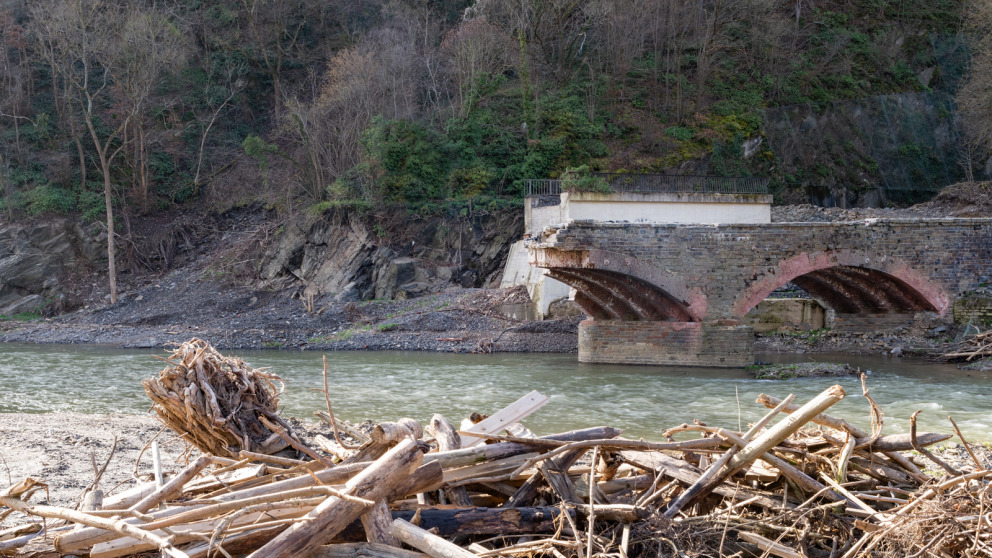Communication is key
02.03.2022

Adequate crisis communication is the key to managing crises like floods or the coronavirus pandemic. But it can only succeed if communicators first familiarise themselves with the human response patterns that can accompany a crisis. It is also important for them to be transparent about existing uncertainties as well as the implications of the crisis for the economy, policymaking and society, since concealing negative consequences or uncertainties jeopardises the public’s trust.
How do humans react to crisis situations?
Though highly simplified, it has proven useful in crisis research to differentiate between three anthropological response patterns: freeze, flight and fight.
Those who freeze, or ignore a crisis, tend to deny information about the level of threat and even to suppress it. They attempt to keep to their normal routines and hope that the crisis will soon be over.
Those who flee retreat to the safety of their homes, minimise contacts and steer clear of anyone or anything that is linked to the threat.
Those who fight consciously and courageously try to defend themselves against the threat. Especially in the case of floods, we have seen many people underestimate the power of floodwater and other natural threats, thinking that they could bravely defy the danger to help others.
Crisis communication must speak to all three patterns simultaneously. Those who tend to ignore a threat can be reached with an appeal to their altruism (actions that serve to protect everyone) or by showing that in future they too could be affected by similar events due to changing circumstances (climate change, for example).
Those who tend to flee can be encouraged in this behaviour circumstances require that they be motivated to take action, particularly where the decision to take shelter in their homes is likely to put them in harm's way.
Communicating with people who tend to fight can be particularly difficult. Members of this group are likely to be more receptive to communications that provide information and recommendations on how to mitigate flood damage such as guidance on sealing low windows or doors, how to use sandbags, and how neighbours can support one another.
In crisis situations, even in the face of extreme threats, one seldom sees widespread panic. If anything, panic breaks out when the threat is highly uncertain but is felt to be tangible by most people. The mantra ‘there is no need to panic’ is, if anything, counterproductive. In fact, this itself could cause some people to panic.
Risk assessment mistakes
Risks are easily overestimated when people are a) highly uncertain or nervous about their consequences and implications and/or b) the consequences of the risks are dramatic and plain to see (for instance in pictures of overcrowded hospitals and houses after a landslide). Unfortunately, people rarely consider the probability of a risk occurring when making decisions. Similarly, people are usually only confronted with linear phenomena and thus tend to underestimate exponential threats.
When the impacts of threats follow a normal statistical distribution (bell curve), they often lead to polarised behavioural patterns. While some people are firmly convinced that they are the famous exceptions who are immune to the threat, those who see themselves as particularly at risk are convinced of their own vulnerability. They are extremely attentive to their safety (which is common for flight) and tend to overreact to danger.
These opposing response patterns can lead to bitter conflicts between the two groups. The problem is not so much a lack of information (both – perhaps unconsciously – refer to the same, statistically correct normal distribution) as where they position themselves along the curve (left: ‘it won’t happen to me, I’ll be just fine on my own’; right: ‘I’m always the first one to get it; better safe than sorry’).
Communication is extremely difficult in such polarized contexts and its success rests on mutual trust between communicators and their recipients. A lack of trust can increase the likelihood of human error as official warnings of natural hazards go unheeded. On the other hand, excessive trust in authorities can lead people to firmly believe that the fire brigade, rescue services, etc. will protect them from everything. The first group takes things into their own hands; the second sits and waits. The sweet spot is somewhere in the middle: People see instructions as credible, but they take responsibility for their own safety.
Implications for successful crisis communication
Crisis communication should be centrally coordinated and organised. It must remain consistent, coherent and plausible as events unfold. Whenever a decision is made, it must be clear that all arguments were considered and that there is no one-size-fits-all solution. Possible conflicts of objectives (the pros and cons of an evacuation, for example) can and should be discussed openly, but in the end, there should be no doubt as to the validity of the decision made.
It is important that there is a central crisis management team that reliably and continuously expresses and explains the authorities’ messages to the public. Of course, other organisations or societal groups will create and deliver their own messages (which is fine in a pluralistic democracy), but the authorities charged with crisis management should always speak with one voice. This only works when all responsible bodies have put together a crisis communication team that is ready to respond in case of emergency. Drills and simulations which engage the affected population are very useful in this context.
Moreover, several channels should be used simultaneously. Sirens are practical for alerting people to high risk situations (especially when the risk is vague). Digital formats are crucial both for crisis communication and suggesting possible courses of action. Apps that give focused diagnoses of the situation on the ground are especially effective, as many international studies show.
In addition to (clear, honest, understandable, coherent) content, word choice is also important in crisis communication. Words that cause alarm should be avoided. Moreover, compliance should not be illustrated with negative examples (transgressions), but with positive ones (‘85 per cent of people follow the rules: Why don’t you, too?’). The term panic should be avoided if possible, and words like hysteria or irrationality should not be used to describe exaggerated reactions.
Descriptors like disaster of the century, mega disaster and existential crisis should also be avoided – these words paralyse and lead to fatalism, not higher levels of compliance. Words like crisis or natural catastrophe are sufficient labels. The same is true of emotionally charged expressions: In the context of the pandemic, it would be better to say spatial separation rather than social distancing (after all, at least virtual contact should be encouraged).
Communicating the uncertainties and consequences of the crisis
In crisis communication, it is not just a matter of offering the most appropriate course of action to cope with natural catastrophes. To maintain trust, uncertainties should be addressed openly. That being said, uncertainty can lead to more anxiety and a feeling of impending doom, so any remaining doubts should be dealt with as thoroughly as possible to show how they can best be coped with. Information about the current crisis should be conveyed as unambiguously as possible; it should have scientific backing and not be linked to political or any other interests.
Whitewashing facts is counterproductive, and so is excluding anything that might be viewed critically. But the basic message should be that different institutions and organisations that serve to protect the public from catastrophes and crises have the means and expertise to deal with these challenges, even after the crisis occurs (for example climate change). Of course, the possibility of setbacks and economic losses must be pointed out, but ultimately it is important that crisis communication offers an optimistic and forward-looking perspective on efforts to alleviate the impacts of crises.
